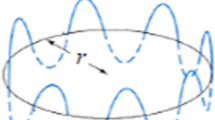Abstract
Entangled states provide the necessary tools for conceptual tests of quantum mechanics and other alternative theories. These tests include local hidden variables theories, pre- and postselective quantum mechanics, QND measurements, complementarity, and tests of quantum mechanics itself against, e.g., the so-called causal communication constraint. We show how to produce various nonlocal entangled states of multiple cavity fields that are useful for these tests, using cavity QED techniques. First, we discuss the generation of the Bell basis states in two entangled cavities, when there is at most one photon in either of the cavities, and then a straightforward generalization to similar N-cavity states. We then show how to produce a nonlocal entangled state when there is precisely one photon hiding in three cavities. These states can be produced by sending appropriately prepared atoms through the cavities. As applications we briefly review two proposals: one to test quantum mechanics against the causal communication constraint using a two-cavity entangled state and the other to test pre- and postselective quantum mechanics using a three-cavity entangled state. The outcome of the latter experiment can be discussed from the viewpoint of the consistent histories interpretation of quantum mechanics and therefore provides an opportunity to subject quantum cosmological ideas to laboratory tests. Finally, we point out the relation between these schemes and the schemes suggested for quantum computing, teleportation, and quantum copying.
Similar content being viewed by others
REFERENCES
J. S. Bell, Physics 1, 195 (1964).
D. Greenberger, M. Horne, and A. Zeilinger, in Bell's Theorem, Quantum Theory, and Conceptions of the Universe, M. Kafatos, ed. (Kluwer Academic, Dordrecht, 1989).
B. S. Tsirelson, Lett. Math. Phys. 4, 93 (1980).
M. Hillery and B. Yurke, Quantum Opt. 7, 215 (1995).
J. A. Bergou, Acta Phys. Slov. 46, 241 (1996).
J. Cirac and P. Zoller, Phys. Rev. A 50, R2799 (1994).
P. Bogar and J. Bergou, Phys. Rev. A 53, 49 (1996).
M. Freyberger, Phys. Rev. A 51, 3347 (1995).
C. C. Gerry, Phys. Rev. A 53, 4583 (1996).
T. Sleator and H. Weinfurter, Ann. N.Y. Acad. Sci. 755, 715 (1995).
M. O. Scully and H. Walther, Phys. Rev. A 39, 5229 (1989), in the context of atom interferometry; J. Bergou and M. Hillery, Phys. Rev. A 44, 7502 (1991), in the context of twocavity entanglement; and L. Davidovich, N. Zagury, M. Brune, J. M. Raimond, and S. Haroche, Phys. Rev. A 50, R895 (1994), in the context of teleportation.
Y. Aharonov, P. G. Bergmann, and J. L. Lebowitz, Phys. Rev. B 134, 1410 (1964).
R. Omnés, Rev. Mod. Phys. 64, 339 (1992).
M. Brune, S. Haroche, J. M. Raimond, L. Davidovich, and N. Zagury, Phys. Rev. A 45, 5193 (1992).
J. A. Bergou and M. Hillery, Phys. Rev. A (in press).
J. A. Bergou, J. Mod. Opt. ( in press).
R. B. Griffiths, J. Stat. Phys. 36, 219 (1984).
M. Gell-Mann and J. B. Hartle, in Complexity, Entropy and the Physics of Information, W. H. Zurek, ed. (Addison-Wesley, Redwood City, CA, 1991).
C. H. Bennett, G. Brassard, C. Crepeau, R. Jozsa, A. Peres, and W. Wooters, Phys. Rev. Lett. 70, 1895 (1993).
A. Ekert, Phys. Rev. Lett. 67, 661 (1991).
V. Buzek and M. Hillery, Phys. Rev. A 54, 1844 (1996).
M. Brune, F. Schmidt-Kaler, A. Maali, J. Dreyer, E. Hagley, J. M. Raimond, and S. Haroche, Phys. Rev. Lett. 76, 1800 (1996).
M. Brune, E. Hagley, J. Dreyer, X. Maître, A. Maali, C. Wunderlich, J. M. Raimond, and S. Haroche, Phys. Rev. Lett. 77, 4887 (1996).
A. Kent, “Consistent sets contradict,” Preprint gr-qc/9604012, Los Alamos preprint server.
Rights and permissions
About this article
Cite this article
Bergou, J.A. Entangled Fields in Multiple Cavities as a Testing Ground for Quantum Mechanics. Foundations of Physics 29, 503–519 (1999). https://doi.org/10.1023/A:1018839507274
Issue Date:
DOI: https://doi.org/10.1023/A:1018839507274




